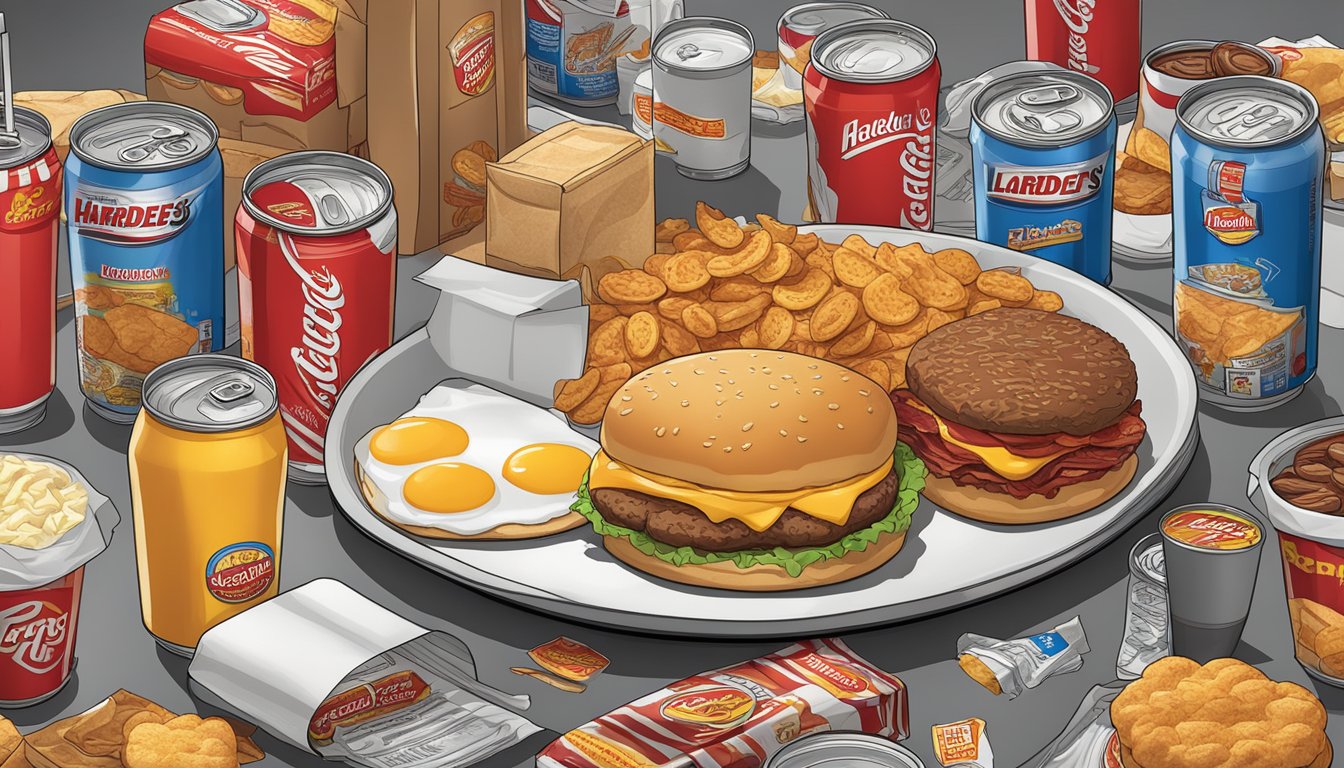The American obesity epidemic emerged in the late 1970s and has steadily risen since, affecting all demographics across the country. During this same period, fast food chains like Hardee’s expanded their breakfast offerings, introducing calorie-dense meals to start the day.
Regular consumption of Hardee’s breakfast items, which often contain high levels of saturated fats, sodium, and sugars, can contribute to weight gain and associated health issues. While these meals may be convenient and satisfying, they reflect broader shifts in American dietary habits that have fueled the obesity crisis.
Examining the relationship between fast food breakfast options and rising obesity rates provides insight into the complex factors driving this public health challenge. It also raises questions about corporate responsibility, consumer choices, and potential solutions to address the epidemic.
The Rise of Fast Food Culture
Fast food transformed American eating habits and reshaped the food industry landscape. The rapid expansion of chain restaurants altered dietary norms and consumer expectations around convenience, speed, and affordability.
Evolution of Fast Food Restaurants
The modern fast food industry emerged in the 1950s with pioneers like McDonald’s streamlining food production. Drive-thru service debuted in 1975, further emphasizing speed and convenience. Menus expanded beyond burgers and fries to include breakfast items, salads, and regional specialties.
By the 1980s, fast food had become deeply ingrained in American culture. Chains aggressively marketed to children through toys, playgrounds, and mascots. The industry also embraced value pricing and combo meals to drive sales.
Fast food restaurants proliferated in urban and suburban areas. Their ubiquity and low prices made them an increasingly common dining choice for many Americans.
CKE and Hardee’s in the Market
CKE Restaurants acquired Hardee’s in 1997, expanding its fast food portfolio. Hardee’s origins trace back to 1960 in North Carolina. The chain built a strong presence in the Southeast and Midwest.
Under CKE ownership, Hardee’s underwent menu and brand overhauls. It introduced thicker burgers and expanded breakfast offerings. The chain adopted a more indulgent, masculine brand image in the 2000s.
Hardee’s competes in the fast food breakfast segment with items like Made From Scratch Biscuits. Its menu aims to differentiate through larger portion sizes and premium ingredients.
Impact of Chain Restaurants on Food Choices
Chain restaurants dramatically altered the American food environment. Their widespread presence made high-calorie, processed foods readily available and affordable. This shifted norms around portion sizes, meal composition, and eating frequency.
Fast food marketing permeated popular culture through ads, product placement, and sponsorships. These efforts shaped consumer preferences and expectations, particularly for children.
The convenience and low cost of fast food made it an attractive option for time-pressed families. However, frequent consumption of these energy-dense meals contributed to rising obesity rates.
Chain restaurants also influenced broader food trends. Their industrial food production methods spread to other sectors. Popular menu items shaped flavor preferences beyond fast food settings.
Analyzing Hardee’s Breakfast Menu
Hardee’s breakfast offerings contain high calorie counts and large portion sizes. The menu features items rich in saturated fat, cholesterol, and sodium. While popular among customers, many options exceed recommended daily nutritional values.
Nutritional Quality of Hardee’s Offerings
Hardee’s breakfast menu items are often high in calories, fat, and sodium. Many options contain processed meats and refined carbohydrates. The Monster Biscuit packs 47 grams of fat and 1,130 mg of sodium.
Healthier choices are limited. The Low Carb Breakfast Bowl provides protein without excess carbs. However, it still contains 600 calories and 47 grams of fat.
Most menu items lack significant fiber or nutrient-dense ingredients. Fruits and vegetables are noticeably absent from many breakfast combinations.
Caloric Content and Portion Size
Hardee’s breakfast portions tend to be large, contributing to high calorie counts. The Frisco Breakfast Sandwich Combo delivers 1,090 calories and includes hash rounds and a beverage.
Many standalone items exceed 500 calories:
- Monster Biscuit: 730 calories
- Loaded Omelet Biscuit: 730 calories
- Bacon, Egg & Cheese Biscuit: 510 calories
These calorie counts represent a substantial portion of the recommended daily intake for many adults.
Popularity of the Monster Thickburger
While not a breakfast item, the Monster Thickburger exemplifies Hardee’s approach to portion sizes. This burger contains:
- 1,420 calories
- 108 grams of fat
- 2,780 mg of sodium
Despite its nutritional profile, the Monster Thickburger remains popular. Its success has influenced other menu items, including breakfast offerings. This popularity reflects consumer preferences for indulgent, high-calorie options at fast food restaurants.
Obesity Epidemic in the United States
The United States faces a significant obesity epidemic, with high prevalence rates among adults and children. Fast food consumption plays a notable role in dietary patterns linked to weight gain and obesity.
Current Obesity Prevalence and Trends
According to recent CDC data, 23 states have an adult obesity prevalence at or above 35%. This represents a concerning trend in the nation’s health. The obesity epidemic varies across demographic groups.
In 30 states, American Indian or Alaska Native adults have an obesity prevalence at or above 35%. White adults in 16 states also show high obesity rates exceeding 35%.
Asian adults, however, do not have an obesity prevalence at or above 35% in any state. This highlights the disparities in obesity rates among different ethnic groups in the United States.
Linking Fast Food Consumption to Obesity
Fast food consumption is closely associated with the obesity epidemic in America. The widespread availability and affordability of high-calorie, low-nutrient foods contribute to unhealthy eating habits.
Fast food meals often contain:
- High levels of saturated fats
- Excessive added sugars
- Large portion sizes
- Limited nutritional value
These factors can lead to increased calorie intake and weight gain over time. The convenience of fast food options makes them a frequent choice for many Americans, potentially impacting overall dietary quality.
Weight Status and Dietary Intake Among Adults and Children
The obesity epidemic affects both adults and children in the United States. Nearly 42% of adults are classified as obese, a rate higher than in most other developed nations.
For children, the situation is equally concerning. The U.S. has the highest level of age-standardized childhood obesity among the 20 most populous countries worldwide, at 12.7%.
Dietary intake patterns play a crucial role in weight status:
- Increased consumption of ultra-processed foods
- Decreased intake of fruits, vegetables, and whole grains
- Higher consumption of sugar-sweetened beverages
These dietary trends contribute to the ongoing obesity epidemic, affecting the health and well-being of millions of Americans across all age groups.
The Role of Nutrition and Public Health

Nutrition and public health play crucial roles in addressing the obesity epidemic. Efforts focus on educating the public about healthy eating habits, promoting nutritional guidelines, and implementing policies to encourage better food choices.
Understanding Nutritional Guidelines
The U.S. Department of Agriculture and Department of Health and Human Services jointly publish the Dietary Guidelines for Americans every five years. These guidelines provide evidence-based recommendations for healthy eating patterns.
Key recommendations include:
- Consuming a variety of nutrient-dense foods
- Limiting added sugars, saturated fats, and sodium
- Balancing calorie intake with physical activity
Nutritional guidelines serve as a foundation for federal nutrition policies and programs. They inform food labeling, school meal standards, and public health initiatives aimed at reducing obesity rates.
Public Health Promotion and Education
Public health agencies work to raise awareness about healthy eating and lifestyle choices. Campaigns often target specific demographics or health issues related to obesity.
Some common strategies include:
- Social media outreach
- Community-based programs
- School-based nutrition education
These efforts aim to empower individuals to make informed decisions about their diets. Public health initiatives also advocate for policy changes to create healthier food environments.
Collaboration between government agencies, healthcare providers, and community organizations is essential for effective health promotion. This multi-faceted approach addresses various factors contributing to obesity.
Effectiveness of Calorie Labeling Initiatives
Calorie labeling on restaurant menus is a public health intervention designed to help consumers make informed choices. The FDA requires chain restaurants with 20 or more locations to display calorie information for standard menu items.
Studies on the effectiveness of calorie labeling show mixed results. Some research indicates that calorie information can lead to modest reductions in calorie intake, particularly among health-conscious consumers.
Factors influencing the impact of calorie labeling include:
- Consumer awareness and understanding of calorie information
- Individual motivation to make healthier choices
- Availability of lower-calorie options
While calorie labeling alone may not dramatically reduce obesity rates, it represents one component of a broader strategy to promote healthier eating habits in the United States.
The Fast Food Environment and Its Impact
The pervasiveness of fast food outlets, limited access to nutritious options, and targeted advertising significantly shape eating behaviors, especially among youth. These factors contribute to the complex relationship between fast food consumption and obesity rates in America.
Proximity to Fast Food Outlets and Eating Behaviors
Fast food restaurants are strategically placed in high-traffic areas, making them easily accessible. Studies show a correlation between the density of fast food outlets and increased consumption.
In urban areas, fast food chains cluster near schools and workplaces. This proximity influences eating habits, particularly for students and busy professionals seeking quick meals.
Research indicates that individuals living within walking distance of multiple fast food outlets are more likely to consume these foods regularly. This frequent consumption is linked to higher calorie intake and weight gain over time.
Access to Nutritious Options in Food Retail Environments
Many neighborhoods, especially in low-income areas, lack grocery stores offering fresh produce and whole foods. These areas, often called “food deserts,” have limited healthy food options.
Convenience stores and fast food outlets dominate these food retail environments. They primarily stock processed, high-calorie foods with long shelf lives.
This imbalance in food availability makes it challenging for residents to maintain balanced diets. Limited access to nutritious foods is associated with higher rates of obesity and related health issues.
The Influence of Food Advertising on Youth
Fast food companies heavily target children and teenagers through various media channels. TV commercials, social media ads, and mobile apps expose youth to frequent food marketing.
These advertisements often feature colorful mascots, toys, and meal deals designed to appeal to younger audiences. Studies show that children exposed to food ads consume more calories and prefer advertised brands.
Fast food marketing also infiltrates schools through sponsorships and branded educational materials. This exposure normalizes fast food consumption from an early age, potentially shaping lifelong eating habits.
Lifestyle Considerations and Obesity
Obesity rates have risen dramatically in recent decades due to changes in diet and activity levels. Addressing this epidemic requires examining key lifestyle factors that contribute to weight gain and implementing targeted interventions.
Importance of Physical Activity
Regular physical activity plays a crucial role in maintaining a healthy weight. Adults should aim for at least 150 minutes of moderate-intensity aerobic exercise per week. This can include brisk walking, swimming, or cycling. Strength training exercises are also important for building muscle mass and boosting metabolism.
Children and teens need 60 minutes of physical activity daily. Schools can support this by offering physical education classes and after-school sports programs. Families can encourage activity by limiting screen time and planning active outings together.
Even small increases in movement throughout the day can make a difference. Taking the stairs instead of the elevator or parking farther from entrances adds up over time.
Balancing Energy Intake and Expenditure
Weight gain occurs when calorie intake exceeds energy expenditure. Understanding portion sizes and reading nutrition labels helps control calorie consumption. Keeping a food diary can increase awareness of eating habits.
Eating regular, balanced meals prevents excessive hunger and overeating. Including protein and fiber at each meal promotes satiety. Limiting sugary drinks and high-calorie snacks reduces empty calories.
Adequate sleep is also important for weight management. Lack of sleep disrupts hunger hormones and can lead to overeating. Adults should aim for 7-9 hours of sleep nightly.
Role of Schools in Nutritional Education
Schools play a vital role in teaching children about nutrition and healthy eating habits. Nutrition education should be integrated into science and health curricula starting in elementary school. Hands-on activities like school gardens and cooking classes reinforce these lessons.
School lunch programs should offer nutritious, appealing meals that meet dietary guidelines. Removing junk food from vending machines and limiting sugary snacks helps create a healthier food environment.
Teaching media literacy enables students to critically evaluate food advertising and make informed choices. Involving parents through newsletters and workshops extends nutrition education beyond the classroom.
Alternatives and Reforms

The fast food industry faces pressure to address its role in the obesity epidemic. Changes in menu offerings, government policies, and consumer preferences are emerging as potential solutions.
Offering Healthier Menu Options
Fast food chains are expanding their menus to include more nutritious choices. Salads, grilled chicken, and fruit cups now appear alongside traditional burgers and fries. Some restaurants list calorie counts on menu boards to help customers make informed decisions.
Chains are also reformulating existing items to reduce calories, fat, and sodium. For example, many have eliminated trans fats from their cooking oils. Portion control options like snack-sized wraps provide lower-calorie alternatives.
Breakfast menus are evolving too. Oatmeal, yogurt parfaits, and egg white sandwiches offer protein-rich options with less fat and calories than traditional breakfast platters.
Policy Approaches to the Fast Food Industry
Governments are exploring regulatory measures to combat obesity. Some cities have banned fast food restaurants near schools or limited the number of chains in certain areas.
Taxes on sugary drinks aim to discourage consumption and raise funds for health initiatives. Similar proposals target high-calorie menu items.
Mandatory calorie labeling on menus is now required for large restaurant chains in many jurisdictions. This policy seeks to empower consumers to make healthier choices.
Some locales restrict marketing of unhealthy foods to children, including limits on toy giveaways with kids’ meals.
Consumer Shifts Toward Health-Conscious Eating
Public awareness of nutrition and obesity risks is driving demand for healthier options. Consumers increasingly seek out fresh ingredients, whole grains, and plant-based proteins.
Fast casual restaurants emphasizing quality ingredients and customizable meals are gaining market share. These competitors pressure traditional fast food chains to improve their offerings.
Mobile apps and online ordering make nutritional information more accessible. Customers can easily compare options and make substitutions to reduce calories or increase nutrient content.
Health-focused meal prep services and meal kits provide alternatives to fast food for busy consumers seeking convenient yet nutritious options.




